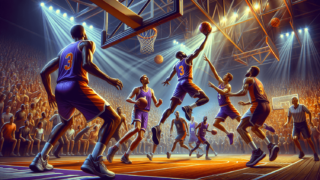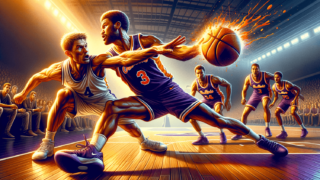What Is a Floater in Basketball?
Written by: Basketball Universe
Last updated:
🏀 Dive into the exciting world of basketball as we explore one of the craftiest moves in the game – the floater! Whether you’re a seasoned fan or just stepping into the court of basketball knowledge, this blog post has everything you need to know about floaters. So, what are you waiting for? Put on your sneakers, grab a ball, and let’s discover the art of the floater in basketball that has players soaring and defenders scrambling to keep up. Get ready to elevate your understanding of this captivating technique, and who knows, you might just find yourself floating like a pro in no time! 🏀
What Is a Floater in Basketball?
A floater in basketball is an offensive move where a player, typically a guard, releases a one-handed shot with a soft touch while driving towards the basket. The shot is designed to sail high over defenders to avoid being blocked, and then drop into the hoop. Often used when facing taller shot-blockers, the floater is an essential weapon in a player’s arsenal to score in the paint without heavy contact.
Floating Through History: The Origins of the Floater
The floater, like many moves in basketball, evolved over time as a response to the growing athleticism and size of defensive players. Although it’s difficult to pinpoint the exact origin of the floater, its earliest version can be traced back to the 1960s with Hall of Famer Nate “Tiny” Archibald, who used a one-handed push shot to score over taller defenders. Fast-forward a few decades, and the floater has become a staple in the modern basketball player’s repertoire.
Float Like a Butterfly: Mastering the Floater Technique
Setting up the Move
What separates the floater from other shots in basketball is the touch and finesse required to execute it well. The first thing to consider when attempting a floater is positioning on the court—most floaters are taken within the key. Choose a spot close to the rim, preferably in the painted area, to avoid being forced into an overly difficult shot. Timing is also essential, as you’ll want to release the ball before the shot blocker has a chance to react.
Dribble and Gather
Before you can think about launching your floater, you need to make sure your dribble is in order. As you move towards the basket, use quick, controlled dribbles to keep your defender guessing. Once you reach the desired spot for your floater, it’s important to gather the basketball with both hands and maintain a low center of gravity. This will help you generate power for the shot while staying balanced and in control.
Body Position and Elevation
As you prepare to launch your floater, your body position will play a crucial role in its success. You’ll want to ensure that your shoulders and hips are squared up to the basket, and your knees should be slightly bent. As you begin your jump, elevate with a strong push-off from your dominant leg. Your shooting side (hip, knee, and ankle) should be in a straight line and aiming towards the basket. This alignment will help you maintain consistency across all phases of the shot.
Release Mechanics and Touch
The secret sauce of the floater is undoubtedly in the release. As you elevate, ensure that your shooting wrist and elbow stay aligned above your shoulder. Your shooting hand should be positioned underneath the ball, and your fingertips should maintain control throughout the shot. The release should be a gentle push or flick, with your shooting fingers pointing towards the basket on follow-through. Remember: it’s called a floater for a reason, so aim to loft the basketball with a soft, high arc.
Know Your Enemies: Defending the Floater
Disrupt the Dribble
If you’re defending against a player proficient in the art of the floater, you’ll want to do everything in your power to make their life difficult. Applying pressure on the dribble and staying low in a defensive stance is a great starting point. Constantly look for opportunities to disrupt the offensive player’s dribble or force them into taking a tougher shot.
Challenge the Shot
As the offensive player releases their floater, try to challenge the shot without fouling. Timing your jump correctly to contest the shot can be tricky, but it’s crucial in preventing an easy basket. Keep your arms extended and aim to deflect the ball without physically contacting your opponent.
Master the Art of Shot Blocking
While floaters are designed to sail over shot blockers, not all attempts are perfect. If you’re a naturally gifted shot blocker, use your wingspan to your advantage. Reading the offensive player’s movements and anticipating when they will release the floater is key. Leap off the ground at just the right moment to squelch their hopes of dropping the ball into the net.
Friends in High Places: the NBA’s Finest Floater Artists
No discussion of floaters in basketball would be complete without mentioning some of the NBA’s most gifted practitioners. Throughout the league’s history, certain players have honed their skills and become synonymous with this delicate art form.
Tony Parker
The French point guard made a name for himself during his time with the San Antonio Spurs, not only for his blistering speed but also for his mastery of the floater. Parker’s signature “teardrop” became a trademark move, leaving many defenders scratching their heads as the ball dropped in seemingly impossible ways.
Steve Nash
Two-time NBA MVP Steve Nash is another player who became infamous for his command of the floater. His exceptional vision and creativity allowed him to find just the right angle and touch to get the ball to the hoop, making him nearly unstoppable in the paint.
Stephen Curry
While widely renowned for his game-changing three-point shooting, Stephen Curry’s floater is another vital weapon in his offensive arsenal. With a knack for exploiting gaps in the defense and an incredible touch on his floaters, Curry is the epitome of a complete offensive player.
From the Playground to the Pros: Incorporating the Floater into Your Game
Practice Makes Perfect
The road to a successful floater begins with constant repetition and practice. Set aside time each day to work on your floater in different positions on the court. As you become more comfortable with the basic mechanics, you can start to experiment with different angles and levels of defensive pressure to simulate real-game scenarios.
Study the Greats
There’s a wealth of knowledge to glean from the players who have come before you. By studying film of the NBA’s top floater artists, you can learn a lot about the subtleties and nuances of this unique basketball move. Observe how players like Tony Parker, Steve Nash, and Stephen Curry use their floater to exploit defensive gaps or create space for their teammates.
Patience and Confidence
Remember, Rome wasn’t built in a day, and neither is a perfect floater. Learning this move takes time, patience, and the belief that you can do it. Stay focused, and continue building your skills step by step. With dedication and practice, you’ll soon be looking like a pro on the court, sending defenders into a frenzy as you float the ball into the basket.
In a game filled with towering giants and defensive enforcers, a floater can be the key to unlocking scoring opportunities for undersized guards. By perfecting the floater, a player gains a versatile weapon for overcoming height disparities, allowing them to score despite being surrounded by tall and agile defenders.
Moreover, executing a perfect floater adds an element of unpredictability to a player’s game. Defenders may anticipate a pass or jump to block a layup, but a well-timed floater can leave them flat-footed and unable to defend the shot. This element of surprise will allow for higher-percentage scoring opportunities and can elevate a player’s offensive impact on the game.
Adapting the Floater: Different Flavors for Different Players
Floaters come in many shapes and forms, depending on individual players’ styles and preferences. Not every floater has to follow the traditional one-handed shooting motion. Various adaptations and modifications can make this versatile move even more effective for different situations and players.
Two-Handed Scoop Shot
Some players prefer a two-handed scoop shot, using both hands to cradle the ball and guide it towards the hoop. This technique offers added protection from defenders, shielding the ball from would-be shot-stealers. However, this method may require a bit more touch and control to produce the desired loft and arc on the shot.
Runner
A runner is a variation of the floater where the player takes a one-handed shot while moving at full speed towards the basket, typically without a jump. The momentum generated by sprinting helps to propel the ball towards the hoop. This move requires excellent touch and balance to ensure that the shot isn’t too powerful or off-target.
Finger Roll
Another variation, the finger roll, may resemble a layup at first glance, but it involves a unique shooting motion. Instead of releasing the ball with a push or flick, the player softly extends their arm and allows the ball to roll off their fingers for a gentle touch. Often utilized by taller players with long wingspans, the finger roll demands impeccable timing and finesse.
Adding the Floater to Your Workout Routine
When practicing your floater, try incorporating drills into your workout routine that specifically target the skills and techniques you need to improve. Dedicate a portion of your practice time to developing and honing this particular shot to increase your proficiency.
Mikan Drill
Create a smooth, controlled layup by practicing the Mikan Drill, which alternates between left and right-handed layups. Developing a softer touch near the hoop during the Mikan Drill will also work wonders for your floater game.
One-Foot Jump Shooting
Focusing on one-foot jump shooting, a staple of the floater, can help improve your balance, technique, and control. Practice taking shots off one foot with a gentle touch from various spots around the key.
Defensive Pressure Simulation
While practicing floaters, consider recruiting a friend or teammate to provide simulated defensive pressure. Challenge yourself to perform the floater under various levels of pressure to replicate in-game situations.
By honing your craft, studying the game’s greats, and incorporating the floater into your arsenal, you’ll be equipped to conquer any defense and elevate your basketball prowess to the next level.
Frequently Asked Questions: Mastering the Floater
Ready to further elevate your expertise on floaters in basketball? Here are 13 common questions and concise answers based on insights from the basketball world, to help you better understand and appreciate this dynamic move.
1. What is the main purpose of a floater in basketball?
The primary purpose of a floater is to score in the paint against taller defenders or shot blockers, making it an essential offensive move for smaller players or guards who need a quick-release shot.
2. Can taller players use floaters effectively?
Yes, taller players can effectively use floaters to keep their opponents guessing and diversify their offensive arsenal, making them even more challenging to defend.
3. How does a floater differ from a jump shot or layup?
The floater is set apart from jump shots and layups by its gentle release, the touch required to execute it, and the higher arc created while propelling the ball toward the basket.
4. What is the best way to practice floaters?
Practice floaters by setting up positions close to the rim and focusing on your balance, body position, and release mechanics. Additionally, incorporate specific drills, like the Mikan Drill and One-Foot Jump Shooting, into your routine to refine your skills.
5. Which NBA players are known for their floaters?
Some NBA stars renowned for their floaters include Tony Parker, Steve Nash, and Stephen Curry, each of whom has used the move effectively to complement their primary offensive skills.
6. Can floaters be used effectively in all offensive systems?
Yes, a well-executed floater can work effectively in virtually any offensive system, as it provides versatility, unpredictability, and an additional weapon for players to exploit the defense.
7. How do defenders attempt to stop floaters?
Defenders can disrupt floaters by applying pressure to the offensive player’s dribble, challenging the shot without fouling, and timing their attempts to block or deflect the shot.
8. Is the floater dangerous to execute?
The floater is not inherently dangerous, but as with any basketball move, it’s important to practice good form and body control to minimize the risk of injury.
9. Can a floater be blocked?
While floaters are designed to float over shot blockers, they can still be blocked if executed poorly or if a defender anticipates and times their jump correctly.
10. How can I increase the chances of making a floater?
You can improve your success rate with floaters by consistently practicing proper technique, gaining experience under varying levels of defensive pressure, and studying the game’s top floater practitioners.
11. Can floaters be used to create space for teammates?
Floaters can draw defenders toward the shooter, thus creating openings for teammates. A well-rounded offensive player can utilize the floater to exploit mismatch situations and free up their teammates for open shots.
12. Are there different forms of floaters?
Indeed, there are various types of floaters such as the classic one-handed release, the two-handed scoop shot, the runner, or the finger roll. Each variation has its advantages and challenges to contend with.
13. Is it necessary to jump high when attempting a floater?
Jumping high is not a requirement; rather, quickly elevating off the ground and releasing the ball with a high arc is more important when attempting a floater. This will help ensure the ball floats over defenders and increases the ball’s chances of dropping in through the hoop.
Featured Posts
- No pillar pages found.





